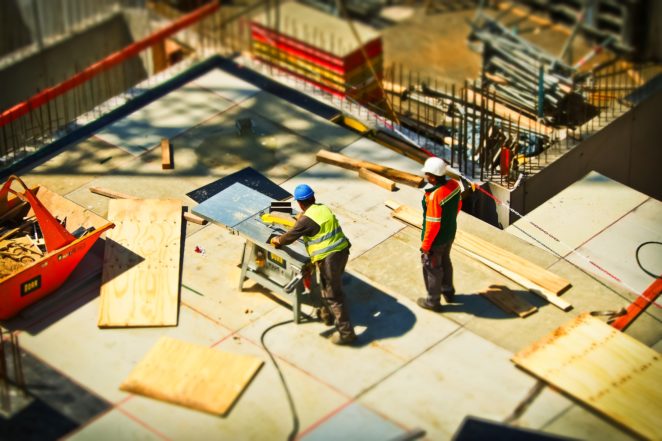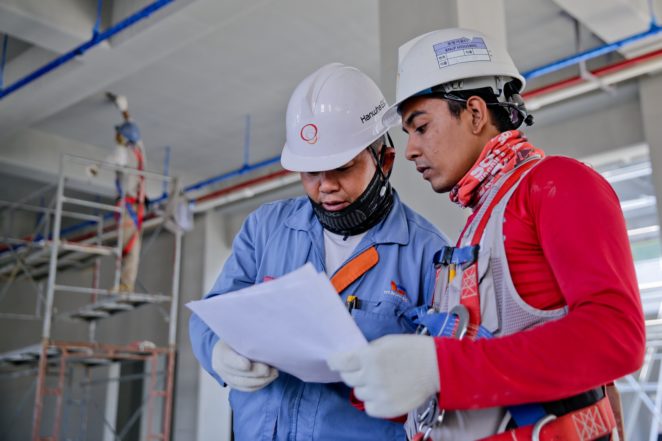
Since humans began constructing buildings, there have been occupational hazards associated with working at high heights, operating machinery and equipment, and lifting heavy loads. Even today, as general contractors and industry partners do more and more to protect the modern worker with regulations and improved safety training and equipment, there are still material safety risks at the construction site. In 2016 there were 991 total construction project-related deaths in the United States, accounting for more than one of five of total private industry fatalities.
Insuring a project and workers can be a costly affair. Owners, general contractors, and even workers need to shield themselves from the possible liability that comes with doing business in the built world.
Fortunately, the industry is capitalizing on the emergence of innovative, IoT technologies to assess, quantify and combat these risks. One of the most promising risk-reducing solutions is wearable technology. Worn by workers – whether on the belt or elsewhere – these devices collect and provide information about workers as they move about the jobsite, helping to improve identification and response to incidents and mitigate overall exposure.

In late October, Travelers, Gilbane Building Company, and Triax announced a partnership to explore the potential of wearable devices and real-time data to elevate worker and overall site safety, quantify and mitigate risks, and potentially reduce overall losses.
“What’s really great about this partnership is that there is a lot of talk in both the construction and insurance worlds about the adoption of IoT (internet of things) and wearables,” said Pete Schermerhorn, President and CEO of Triax Technologies. “It’s really great to see three companies putting something concrete in play. That’s the only way that increased adoption and utilization of these technologies, and then lower risk environments, will be achieved.”
Triax’s flagship Spot-r platform monitors workers and equipment via devices worn on workers or tagged onto equipment and machinery. The wearable, for example, can detect worker falls and push a notification to designated personnel, telling them the type of alert and location, so appropriate and medical attention can be deployed.
It’s really great to see three companies putting something concrete in play. That’s the only way that increased adoption and utilization of these technologies, and then lower risk environments, will be achieved.
Gilbane has been working with Triax for over 18 months. After using the technology on a project site in Fairfield, Connecticut, the construction company spoke with Travelers, who insures many of the constructor’s projects, about the technology’s potential.
“There are a number of products that help you understand where people are deployed and in the event of an emergency, help you know where everyone is and confirms that everyone is evacuated,” said Donald F. Naber, Senior Vice President, Director of Risk Management at Gilbane. “Triax and their Spot-r system provide all of that and then some. The differentiator for us was Triax’s ability to track falls from heights.”
Gilbane currently uses Spot-r at 10 job sites, and this partnership will examine data collected from two of these projects that are insured by Travelers: a manufacturing plant in North Carolina and a 60,000-square-foot, six-story building in New York City.
Through this partnership, data collected on Gilbane’s job sites will be shared with Travelers in an effort to understand how this technology can help mitigate safety risks and increase the overall level of worker safety.

“At the end of the day, we will have better insight into the kinds of things that are happening on site,” said to Bob Kreuzer, Vice President of Construction Risk Control at Travelers. “Our objective is to develop a stronger point of view around how wearables can be leveraged on the job site to help protect workers.”
One of the things that most excites Travelers is the ability to combine new Spot-r safety and productivity data with key loss statistics and insights they’ve collected over the years. According to Kreuzer, Travelers’ loss data indicates that about 43 percent of workers’ compensation losses occur with employees in their first year of employment.
“In that instance, we can take that loss data and help customers make a change in how they approach a certain segment in the workforce, utilizing new technology tools like Spot-r,” he said. The Spot-r system, for example, can set custom notifications for new workers, when a certain trade arrives on site, or even when an OSHA certification is set to expire.
Our objective is to develop a stronger point of view around how wearables can be leveraged on the job site to help protect workers.
Triax is confident that the data it provides will benefit both the construction and insurance industries.
“Automatic fall notifications or push-button alerts, which provide the worker with the ability to communicate their location, name, and the fact that something has happened to a supervisor at any point in time from anywhere in the field helps improve response in real-time,” Schermerhorn. “As you begin to amass aggregate historical data, specific risk factors or profiles which are quite meaningful for claims management and administration will begin to emerge – that’s where this is going and what we’re most excited about.”
All three companies are excited about this collaboration and the data dividends it could yield. Working together, Gilbane, Triax, and Travelers have the potential to provide some potent insights about job site safety across project sites.
“Each one of us [the three companies] is really good on our own using and leveraging data,” said Kreuzer, “but collectively we can be that much stronger.”
This article was brought to you by Triax Technologies.


Discussion
Be the first to leave a comment.
You must be a member of the BuiltWorlds community to join the discussion.